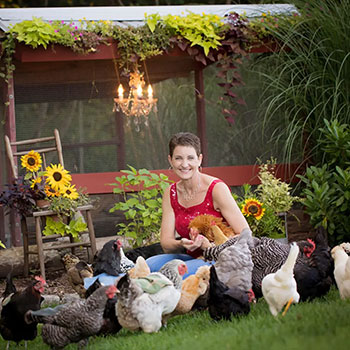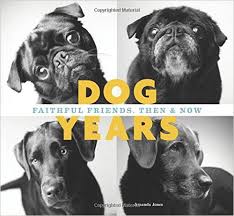The Chicken Chick
Kathy Shea Mormino
 Chickens are more popular than ever in urban settings and as pets. By popular demand, we're having the Chicken Chick on the show to share her vast chicken knowledge. Even if you aren't considering a fowl friend, Kathy Mormino will amuse and educate.
Chickens are more popular than ever in urban settings and as pets. By popular demand, we're having the Chicken Chick on the show to share her vast chicken knowledge. Even if you aren't considering a fowl friend, Kathy Mormino will amuse and educate.
As an attorney by trade, accidental photographer and backyard chicken-keeper, Kathy Shea Mormino is the founder and one-woman creative force behind the blog, "The Chicken Chick," and her wildly popular Facebook page and social media network.
Kathy wants people to know that chickens do have personalities and they are characters. They come in a wide variety of colors and sizes and attitudes! They are also smart little creatures and creatures of habit. For example, if you gave them a delicious treat one day (like corn on the cob) every time they see you they will expect that of you!
Backyard chickens are becoming more popular across the country. From urban to suburban settings, people are raising chickens. Chickens are no longer just the livestock that our grandparents tended to, but have now become pets, along with our cats and dogs.
Most people who get backyard chickens don't initially intend to get them as pets, but they become pets very quickly. It's very easy to bond with a 2-ounce chick!

Besides chickens, Kathy also has roosters and several cockerels. When asked why she has roosters, as she doesn't need them for the chickens to lay eggs, Kathy responds, "Funny you should ask that. Nobody ever asks what do you need a dog for? Dogs don't create food, do they?"
Kathy also wanted to address the fad of people putting sweaters on their chickens. Dressing pet chickens in sweaters has become something of a fad in backyards across America, a trend not entirely different from the Pet Rock of the 1970's - silly, cute and unnecessary. Photos of hens wearing sweaters are being shared on social media channels like the common cold in kindergarten class, photos that no doubt fuel the practice where it ought not to be encouraged. The average chicken does NOT NEED a sweater. Kathy states, "I am the first in line to encourage the proper care and keeping of pet chickens and can anthropomorphize my pets with the best of ‘em, but the truth is, sweaters do not help backyard chicken and if I believed they did, I would use them and encourage their use. While it's fine to engage in a little silliness with our chickens from time-to-time, sweaters are not only unnecessary, they can be dangerous."
Before getting any chickens, check with your city to see if they are legal to own. Regulating backyard chickens is a major issue around our country today. Who would have thought 50 years ago that you would have to request permission from your city to feed your family? Very few municipalities regulated chickens years ago, because that is how you fed your family.
Kathy balances blogging, writing, crafting, cooking and parenting her two girls with her husband and her own flock of over 60 feathered pets and a dog with a "cattitude."
Visit Website
Faithful Friends Then & Now
Amanda Jones, Dog Years
 Amanda Jones is one of the top best pet photographers in the nation. One of her collaboration is a coffee-table book with 30 dogs photographed during their youth and again in their senior years. It's a compelling contrast between puppy-hood and a dog's golden years. Amanda will also have tips for photographing your pet.
Amanda Jones is one of the top best pet photographers in the nation. One of her collaboration is a coffee-table book with 30 dogs photographed during their youth and again in their senior years. It's a compelling contrast between puppy-hood and a dog's golden years. Amanda will also have tips for photographing your pet.
In her book, Dog Years - Faithful Friends, Then & Now, Amanda documents the lives and stories of 30 dogs, in black and white photos. By presenting portraits of each dog as a puppy and again as an older dog, Amanda Jones reveals the unique spark of personality that lasts a lifetime.
Lilly, who was Amanda's longhaired Dachshund that passed away, was the inspiration for her book. When Lilly passed, Amanda started working on a memorial card. She pulled photos from the different stages of Lilly's life. When she put them together on the card and sent it to her friends, she received such a strong reaction. She decided she wanted to share it with more people and tried to figure out how she could turn it into a project. That's when she started looking up people whose dogs she photographed years ago.
Amanda was able to go back and photograph dogs that she had photographed when they were young; ten, twelve and sometimes sixteen years later. She then put them side-by-side. These beautiful images of breeds ranging from Golden Retrievers and Great Danes to Pugs and French Bulldogs are accompanied by reflections from loved ones on the lives they share with their furry companions. The result is a celebration of each dog and a tribute to the relationship between man and his best friends.
 Amanda also gives us tips on photographing our pets, especially the black ones. The best thing you can do is find good light. Not direct sunlight, as direct sunlight is not always good light because it causes dogs to squint and can cause harsh shadows. Reflected light, like of the side of a building in the shade is beautiful. Soft window light through a sheer curtain is wonderful. Basically, something that cuts the harshness of the direct sun exposure is good.
Amanda also gives us tips on photographing our pets, especially the black ones. The best thing you can do is find good light. Not direct sunlight, as direct sunlight is not always good light because it causes dogs to squint and can cause harsh shadows. Reflected light, like of the side of a building in the shade is beautiful. Soft window light through a sheer curtain is wonderful. Basically, something that cuts the harshness of the direct sun exposure is good.
You also want to get down low to their level. This can be tricky, as they will want to come to you when you get down on the floor. You need to be sneaky and tell them to stay, if they know that command. Amanda likes to get good expressions and focuses on their eyes. You can really see the heart and soul of a dog through their eyes. Close ups, like headshots; make great shots where you can really focus on their eyes. You need to get them to look at you, and can do this by snapping your fingers, using a whistle or even a squeaky toy or treat, but beware as these can also make your dog want to come to you.
She states that patience is the number one thing that lets her have successful photo shoots. You can't always get the great shot in one try. Amanda takes anywhere from 150 to 200 shots and ends up with a few really goods shots. It just takes time.
Amanda and her husband, Chris, work together from her studio in the northern part of Berkshire County, Massachusetts. She is devoted to her dogs and her cat, and of course, her daughter, Sophie.
Visit Website
Pheromones In Puppy Training - Dr. Debbie

So you just got a new puppy and you have all your training tools at the ready, the collar, leash and dog crate. But beyond that, do you have the one thing that can make your training tasks easier all around? Tap into your puppy's own sense of smell using canine pheromones and ease your new pup's training and transition into the home.
Pheromones are scent signals emitted by all animal species, including humans. Various pheromones work under the radar to influence the perceptions and behaviors of others within a species.
Shortly after whelping, a pheromone is emitted from the bitch's sebaceous (oil) glands located between the mammary glands. The pheromone, dubbed the canine appeasing pheromone, reassures the puppies, calms them and facilitates nursing. The bitch stops emitting this pheromone as the pups mature, but all dogs retain the ability to "read" this pheromone. Not only do older dogs recognize this pheromone, but it continues to have a natural calming effect on canines of all ages.
In veterinary behavior cases, the dog appeasing pheromone is used for dogs with noise phobias, car travel anxiety, separation anxiety and other fearful situations. Various forms are available including pheromone collars, plug in diffusers and sprays. The canine appeasing pheromone doesn't sedate the dog; rather it decreases fear and excitability.
The dog appeasing pheromone is also helpful for newly adopted puppies. Those first few days to weeks in a new home are full of changes for the pup faced with novel environments far from the comfort of mother and siblings. The dog appeasing pheromone has been shown to ease the transition of the pup into new home and improve sociability and training during a pup's critical socialization period.
Pheromone Research
For skeptics that need to see the proof in the studies, veterinary behavior studies have examined the positive influence of the dog appeasing pheromone. When comparing treatment responses for dogs with separation anxiety, the use of the dog appeasing pheromone equaled the benefit of the anti-anxiety medication, amitriptyline.
One study looked at 66 puppies as they settled into new homes after adoption. Approximately half of the puppies wore a pheromone collar and half wore a placebo. The study found that puppies wearing a pheromone collar displayed significantly fewer nuisance behaviors like vocalizations or scratching within 3 days of adoption. Pups wearing the pheromone collar woke their owner's less during the night and displayed fewer signs of distress and vocalizations throughout the course of the study.
The researchers concluded that pheromone collars helped both the pup and family. Pups were less stressed and adapted easier. By decreasing the pup's stress and fearful behaviors, the pet owners found a more enjoyable bonding experience with the new pup and faced less frustration through the training process.
 In another study, puppies 8 to 15 weeks were enrolled in an eight-week long puppy socialization and training class. Half wore a pheromone collar and the other half wore a placebo collar. The pups wearing the pheromone collar were calmer in the face of novel experiences and displayed less fear, anxiety, and aggression. In the end, the pups with the pheromone collar not only were less nervous, but had fewer behavioral problems and learned better. And a long-term effect on sociability was recognized in dogs up to one year after the class and study was completed.
In another study, puppies 8 to 15 weeks were enrolled in an eight-week long puppy socialization and training class. Half wore a pheromone collar and the other half wore a placebo collar. The pups wearing the pheromone collar were calmer in the face of novel experiences and displayed less fear, anxiety, and aggression. In the end, the pups with the pheromone collar not only were less nervous, but had fewer behavioral problems and learned better. And a long-term effect on sociability was recognized in dogs up to one year after the class and study was completed.
Pheromones and My Pup
As a previous owner of a nine-week old Bouvier puppy named Nikki, I used both the pheromone collar and diffuser upon welcoming my new pup home. One day before bringing Nikki home, I placed a pheromone diffuser close to the puppy crate, where it would have maximum benefit during her first nights in the kennel away from mother and siblings. Immediately upon leaving the breeder's home, Nikki was fitted with a pheromone collar to serve as a source of reassuring pheromones that went everywhere she did. The pheromone collar became a tool in Nikki's socialization. It was on her when she met new people or animals, when she explored new environments and during puppy kindergarten class.
Did pheromones help in my pup's transition and training? The four hour drive home from the breeders was a dream, no crying or whining the entire trip. After returning home, Nikki never soiled in her kennel during the day or night. I'll admit I had my share of interrupted sleep in the first two weeks, but most of Nikki's night time wakes were for genuine elimination needs. Overall, her transition into the home was smooth and lacked the wailing, inconsolable cries of a stressed pup.
The canine appeasing pheromone isn't a magic bullet though. Nothing matches a quality pup obtained from a reputable breeder who focuses on health, genetics and early socialization. Likewise, pheromones do not replace the hard work and consistent training efforts that any new pet owner must provide. However, by adding the the canine appeasing pheromone to your new puppy training, you can help your pup become the best he or she possibly can.
Featured veterinarian known as "Dr. Debbie" on national pet radio program, Animal Radio. Ebook author of "Yorkshire Terriers: How to Be Your Dog's Best Friend"; "Pugs: How to Be Your Dog's Best Friend"; "Mini Schnauzers: How to Be Your Dog's Best Friend"; and "Shih Tzu: How to Be Your Dog's Best Friend." Dr. Debbie's books.
Visit Website
Animal Radio News - Lori Brooks

Your Pet's Pupils Can Tell You A Lot
Researchers at the University of California, Berkeley discovered a great deal about what animals' pupils can tell us. For example, when a grazing animal is eating with its head down, a horizontal pupil allows it to keep an eye on its surroundings by rotating up to 50 degrees. This allows them to detect approaching predators coming from the ground. The researchers studied the eyes of 214 different animals, including cats, dogs and snakes, even rhinos. They also noticed that smaller ambush predators, like cats that wait in hiding and ambush their prey, had vertically shaped pupils. That allows them to exclude unnecessary sunlight from their field of vision and catch the best view of their prey.
All Dogs Sold In Pet Stores Must Come From Shelters
For the longest time, rescue groups, shelter volunteers and animal lovers everywhere hoped the day would come when pet stores would sell shelter pups exclusively, as a way to cut the profit from "puppy mills." Well, here's a dream come true story for man. A federal judge in Phoenix, Arizona upheld a city law that required all dogs sold in pet stores must come from shelters, which has helped to relieve shelter overcrowding. Phoenix is one of many cities in the U.S. that have similar laws designed to put an end to puppy mills by driving potential pet buyers toward homeless animals.
 Stronger Sentencing For Animal Fighting
Stronger Sentencing For Animal Fighting
The U.S. Sentencing Commission (USSC) was asked by animal lovers all over the world to get tough on dog fighting by committing to stronger sentencing guidelines for convicted animal fighters and apparently the agency listened. The independent federal agency constructs sentencing guidelines as a reference for federal judges. Its guidelines currently classify animal fighting as a gambling crime. Anyone who has seen footage of a fight or an animal-fighting raid knows that the real harm of these crimes has nothing to do with placing bets
War on Wildlife and Fields Where Food Is Grown is Over
For many years, some of America's biggest producers of fresh salad greens and vegetables waged a quiet war on wildlife surrounding their fields, all in an effort to keep your veggies free of contamination from disease-causing bacteria that can make humans sick. A look at a big pile of safety data suggested that farmers clearing away wildlife habitat did not make field grown food any safer. Ever since the battle started with the great spinach scare of 2006, which was blamed on wild pigs, farmers had been getting rid of any places near their farms where wildlife might hide. They tore out trees, cleared stream banks and created wide strips of bare earth all around their fields. Because of this information, they are no longer required to clear these areas.
 Listen to the entire Podcast of this show (#1235)
Listen to the entire Podcast of this show (#1235)





